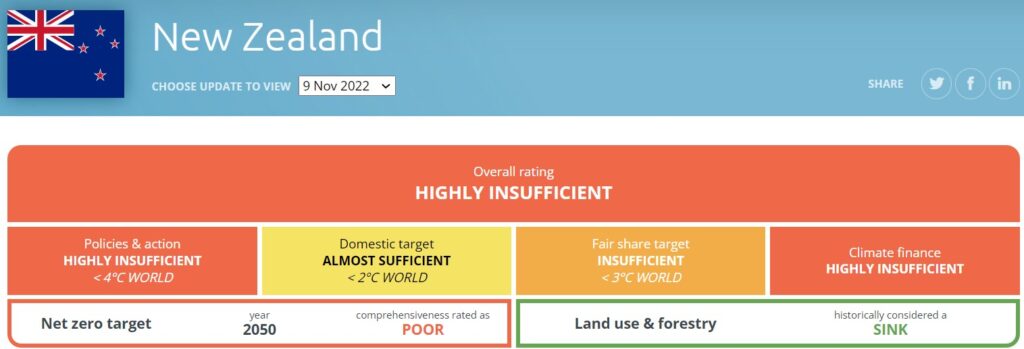As we head rapidly towards the holiday season and the end of a challenging year for many people, we could just wish you a Merry Christmas and Happy New Year and head to the beach. However, since we are facing an economic downturn next year (being engineered by the Reserve Bank in order to cool inflation), it seems a good time to reflect on a few important national sustainability issues that have been in the limelight this year – especially New Zealand’s climate climate change policy.
One of those is the housing ‘crisis’ – a broad term used to cover declining home ownership, unaffordable housing costs (ownership or rent), and increasing homelessness. This country started the year with fast-accelerating property prices and sky-high rents; we end the year with prices dropping, mortgage interest rates soaring, rents still extremely high, and a massive lack of public housing here in the Bay of Plenty – resulting in social problems such as the emergency housing debacle in Rotorua motels.
Another big sustainability issue is water: water pollution, freshwater quality, and especially water reforms. The year started with widespread opposition to the government’s proposed three waters reform from most NZ councils. The year ended with the first piece of 3 waters legislation passed (only Labour voting in support) and even stronger opposition to those reforms from a large majority of the New Zealander population.
Meanwhile, Tauranga has received an exemption from complying with the government’s new freshwater reforms for the next five years, to allow more urban sprawl in swampy areas. It seems growth must proceed, whatever the law says…
Which brings us to climate change. Another year, another UN climate conference … and yet emissions are still increasing – globally, nationally, regionally, and locally in Tauranga and Western BOP.
Back in December 2020, the government declared a climate emergency, after passing the ‘Zero Carbon’ Act the year before. This year saw it release its Emissions Reduction Plan, as well as a more controversial plan to reduce agricultural emissions. So we’ve responded to the emergency and we’re on track … right?
Well no, not really. A few weeks ago, a High Court judge finally released her decision in the case taken by Lawyers for Climate Action (LfCA) against the Climate Change Commission and Minister of Climate Change. It was a technically complex case, and while the judge ruled in favour of the Commission, the decision supported the lawyers’ basic premise: NZ’s climate policy does not align with the Paris Agreement goal to limit global warming to 1.5 to 2.0 degrees C.
“President of Lawyers for Climate Action Jenny Cooper KC said while the court found against them, it had accepted their evidence that the Climate Change Commission’s advice to the Government isn’t aligned with what is needed to stop global temperatures rising above 1.5C.
“It’s also very worrying that it was found that the Act doesn’t actually require New Zealand to cut emissions in line with reaching the global 1.5C goal. This means that we need to look at whether the Act itself is fit for purpose.”
Minister James Shaw said he “will review the Zero Carbon Act after a judge found it regarded meeting a global 1.5C temperature rise limit as an “aspiration rather than an obligation”.“
Which leaves us in an interesting situation. We (the public) were told by the government that NZ’s ‘Zero Carbon’ Act was world-leading legislation, intended to align this country with most other developed countries by aiming to cut our emissions in half by 2030 (this government’s updated Paris Agreement target). At the time, the Minister stated “as far as we are aware, it is the first legislation in the world to make a legally binding commitment to living within 1.5 degrees Celsius of global warming.“
However, this court ruling explicitly states that it is not “a legally binding commitment“. Even though the IPCC and world experts state that global warming will go well beyond 2 degrees if global emissions are not slashed this decade by developed countries. They’ve also stated that ‘net zero’ emissions targets for 2050 are insufficient on their own, yet the court agreed with the Climate Change Commission that a net zero 2050 commitment without large cuts this decade was allowed under the Act.
What’s more, the judge stated that the Act’s amended purpose (“to
contribute to the global effort under the Paris Agreement to limit the global average temperature increase to 1.5˚ Celsius above pre-industrial levels“) was only an “aspiration”. The Minister argued that the words “contribute to” “are more consistent with an aspiration rather than an obligation”… and the judge agreed!
Which means it’s unlikely that future governments and councils, as well as the people living in this country, will treat this aspirational goal as seriously as a statutory target.
The Act also requires the Minister to set emissions budgets “with a view to meeting the 2050 target and contributing to the global effort under the Paris Agreement to limit the global average temperature increase to 1.5˚ Celsius above pre-industrial levels“.
The judge made it clear that those budgets need to weigh up multiple considerations, including “economic circumstances and the likely impact of the Minister’s decision on taxation, public spending, and public borrowing” and “the implications, or potential implications, of land-use change for communities“.
Which vindicated the Minister, who had approved budgets that will only cut NZ’s CO2 emissions by about 20% by 2030, with nitrous oxide reduced by only about 6%, and methane by 10%. The rest of NZ’s contribution towards it’s so-called 50% cut in emissions (actually much less than 50% using the same methodology as other countries) “to contribute to the global effort under the Paris Agreement” will be made in the form of cash: to buy carbon credits from foreign countries.
Which leaves us with a few questions:
- Do New Zealanders really prefer to pay foreign businesses to plant trees (or just to not chop down trees), rather than actually reduce emissions in this country? Especially when a big chunk of our planned domestic emissions reductions to 2050 will already come from tree planting in this country?
- Are New Zealanders happy to pay foreign investors the market price for those carbon credits (estimated $30 billion for the current decade)?
- Is that really a better option than investing the $30 billion into low carbon infrastructure in this country? Keeping in mind that things like solar hot water systems, upgraded electric rail, and better public transport services will result in many additional co-benefits (e.g. less congestion, increased productivity, improved resilience, less air and water pollution, better health outcomes).
This is a bigger issue than many people realise. New Zealand is an outlier in the world. We are the only country to go down this track and use a ‘gross-net’ accounting system and then plan for most of our emission reductions to come from paying foreigners for carbon credits.
Yes, NZ has an unusual economy, with a big emphasis on agriculture and a relatively large amount of renewable electricity. However, even excluding agricultural methane emissions, there is lots more that the government could do to make big cuts in carbon dioxide and nitrous oxide emissions, and to increase the transition to renewable energy (as opposed to just renewable electricity).
The current government has ordered a number of sector decarbonisation plans and is focused on (sort of) decarbonising the public sector, as well as tinkering around the edges of the Emissions Trading Scheme (ETS). It has also implemented some specific policies, such as subsidising people who can afford EVs. However, at the same time, it has also been subsidising fossil fuels (through the 25c per litre fuel subsidy) and has held off implementing most of the big changes that could drastically cut NZ’s carbon emissions.
Instead, the government will invest most of its climate change spending on foreign carbon credits, while continuing to allow additional ETS credits to be issued (meaning another 8 million tonnes of domestic emissions) and retaining the 100% ETS credits given to foreign companies planting pine trees on our high country farms. Hopefully those trees will end up being harvested, but even if they are, the logs will mostly be shipped unprocessed to China… until China becomes self-sufficient in the 2030s.
In case you think we’re being a bit hash in our judgement, this is how the independent Climate Action Tracker website shows NZ’s status:

By comparison, the USA (and Australian) summary looks like this:

While neither policy position is great, the difference is that if everyone took NZ’s approach, rather than the US or Australian policies, the world would be another 1 degree C warmer at the end of this century – something that would heavily impact young people living today.
Meanwhile, the government is ramping up immigration again, to support its economic growth goals, and is mostly leaving it up to councils and ratepayers (and water consumers i.e. everyone) to pay for the increasing costs of infrastructure needed to cope with the adverse social and environmental impacts of all that growth. As last year’s NZPC report stated “New Zealand has had some of the highest per capita rates of both inward and outward migration in the OECD“, yet we spend less on infrastructure than most developed countries.
Bernard Hickey put it this way:
“It’s easier to think magically that we can have it all (high GDP and land value growth growth, low taxes, low interest rates and low investment), and hope someone else takes the hard decisions some time in the politically distant future to either lift taxes and investment to lower housing costs relative to incomes, or to limit population growth by restricting migration.“
What’s more, on this occasion Hickey doesn’t mention the big elephant in the room: climate change policy. If NZ is really serious about cutting emissions, we need to invest lots more into a low carbon economy AND also cut back on unsustainable growth.
As a sustainability expert mentioned recently “People don’t seem to realise that the economy still runs on oil”. Growing an unsustainable economy will not solve our problems – it will only delay the inevitable day of reckoning.
In case the government still isn’t sure what it could do right now to cut emissions, here are ten specific suggestions:
- Fast-track North Island rail upgrades, including electrification of North Island and East Coast Main Trunk lines to make them suitable for new ‘tri-mode’ trains.
- Fast-track a much bigger public housing programme to address the big waiting list on the Housing Register (building sustainable homes along public transport priority routes).
- Stop funding any more infrastructure that enables unsustainable, high-carbon developments – such as Tauriko in Tauranga, and the Cameron Road “future proofing” project.
- Urgently develop a national low carbon Ports and Freight strategy, based around greater use of rail freight, coastal shipping and inland ports such as Ruakura.
- Urgently develop a national Energy Policy to better manage the rollout of renewable electricity infrastructure and to support the renewable energy transition.
- Incentivise solar hot water systems on homes and PV systems on commercial buildings (via targeted subsidies, development contributions rebates, rates rebates, or financing via rates bills.
- Speed up the phase-out of coal burners (currently allowed until 2037) – this is needed to halt the record amounts of coal imports that NZ has been burning in recent years to produce electricity, as well as the NZ coal used to produce milk powder.
- Ensure the fossil gas transition plan (being developed next year) phases out natural gas and LPG ASAP.
- Invest more funding into public transport in NZ cities – providing attractive, affordable, and on-demand options.
- Give the $30 billion to New Zealanders to reduce emissions here in NZ, rather than paying it to foreigners.
There are lots of other things that the government could also do, including aligning the Emissions Trading Scheme with its emissions budgets. However, the Lawyers for Climate Action court case has shown us that NZ does not have transparent climate policies and they and are inconsistent with the goal to limit warming to 2 degrees – so sorting out those issues needs to be the priority.
The 2023 election seems a good time to decide whether any of the major NZ political parties are serious about reducing carbon emissions, or whether they are content to declare a climate emergency and then continue to treat their climate goals as an “aspiration rather than an obligation”.

